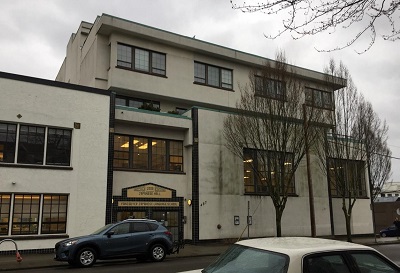Vancouver Japanese Language School National Historic Site of Canada
Vancouver, British Columbia

Vancouver Japanese Language School
(© Jennifer A. Cousineau, Parks Canada / Parcs Canada, 2018)
Address :
487 Alexander Street, Vancouver, British Columbia
Recognition Statute:
Historic Sites and Monuments Act (R.S.C., 1985, c. H-4)
Designation Date:
2019-06-05
Dates:
-
1928 to 1928
(Construction)
-
1928 to 1928
(Established)
Event, Person, Organization:
-
Sharp and Thompson, architects
(Architect)
Other Name(s):
-
Vancouver Japanese Language School
(Designation Name)
-
Vancouver Japanese Language School and Japanese Hall
(Other Name)
-
Vancouver Nippon Kyoritsu Go Gakko
(Other Name)
Research Report Number:
2018-06
Plaque(s)
Approved Inscription:
Founded in 1906 and moved to this Art Deco building in 1928, this educational institution was the first and largest Japanese language school in Canada before the Second World War. After Canada declared war on Japan in 1941, the government forcibly relocated people of Japanese descent away from the coast, seized their property, and closed all 50 existing Japanese language schools. Community leaders managed to prevent the sale of this building, reclaimed ownership in 1952, and reopened the school in 1953. One of the only properties returned to Japanese Canadians after the war, it remains a powerful symbol of community resilience.
Description of Historic Place
Vancouver Japanese Language School National Historic Site of Canada is located in Japantown, in the Downtown East Side neighbourhood of Vancouver, British Columbia. Built in 1928, this two-storey, flat-roofed early modern building is designed in the Art Deco style with a white stucco exterior. A community hall was added in 2000. The school stands on the northeast corner of Alexander and Jackson Streets in a dense urban environment of mixed residential, commercial, and industrial architecture. The designation refers to the footprint of the building (the 2000 addition is excluded).
Heritage Value
The Vancouver Japanese Language School was designated a National Historic Site of Canada in 2019. It is recognized because:
It is a rare surviving example of an interwar language school in one of British Columbia’s oldest immigrant neighbourhoods. It was the first and largest Japanese language school in Canada and one of 50 such schools in use before 1941; Of thousands of properties confiscated from Japanese Canadians by the federal government during the Second World War, it is one of very few known buildings to have been returned to its owners after the period of internment. It bears witness to the persistence of Japanese Canadians during wartime and post-war campaigns to recover their possessions and properties; Designed by Sharp and Thompson, one of British Columbia’s most successful architecture firms, this functional and elegant Art Deco school speaks to the growth, financial success, and cultural integration of Vancouver’s Japanese community in the pre-war period.
The Vancouver Japanese Language School (VJLS) is a rare surviving example of an interwar language school in one of British Columbia’s oldest immigrant neighbourhoods, known as the Powell Street neighbourhood, “Little Tokyo,” Japantown, or Paueru-gai (in Japanese). Founded in 1906 at an adjacent site, the new building was constructed at its current location in 1928. It was the first and largest Japanese language school in Canada and one of 50 such schools in use before 1941. A highly valued community institution offering immersive education in Japanese language and culture, the VJLS is a site of memory for Japanese Canadians. It speaks to the history of their urban life, as well as to their interwar immigrant experiences. The school reflects the community's economic vibrancy, the priority accorded to education, and the aspirations of Japanese Canadians in Vancouver to integration within Canadian society. During the Second World War the school was confiscated and used by the Department of National Defence, but was not sold. In 1953, after years of petitioning, the federal government returned the school to the Japanese Canadian community. The building still functions as a school and retains the aesthetic of a 1920s school building.
Source: Historic Sites and Monuments Board of Canada, Minutes, June 2018.
Character-Defining Elements
Key elements contributing to the heritage value of this site include: its historic associations with Japanese immigration, with the education of Japanese
Canadians, and with the evolution of Japantown as a distinct cultural community; its location on the corner of Alexander and Jackson Streets in Downtown East Side Vancouver; its low massing, flat roof and early modern Art Deco Style design with minimal exterior ornamentation including three-bay façade, central inset entrance, raised parapet, four sets of three large, symmetrical multi-pane windows, central bay’s arched windows, stucco mullions with spiral forms, sloped brick window sills, the remaining original wood frame windows, the white-painted stucco exterior walls, and black tile banding of the main entrance and façade, and inscriptions above the entrance “Japanese Hall” and “1928” in black, green, and yellow tiles; the light-filled interior and original clear plan, with classrooms and offices around a central hall; original materials including Douglas-fir framing, simple interior finishes and original features including plaster walls and ceilings, blackboards, fir flooring, tongue and groove wainscoting and stairs, bannisters with moulded fir caps and blocks, heating registers and glazing; its urban setting of mixed residential, commercial, and industrial architecture as part of Japantown, downtown Vancouver.